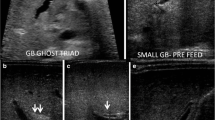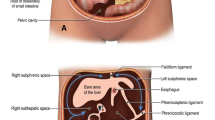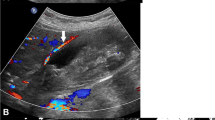Abstract
A wandering spleen is a rare condition with an unknown incidence. The lack of short gastric vessels and suspensory ligaments is thought to result from a fusion anomaly of the dorsal mesogastrium of the spleen. The major risk in performing a splenectomy for patients with a wandering spleen is overwhelming postsplenectomy infection (OPSI). The incidence of OPSI is 0.13% to 8.1%, with a mortality rate of 30% to 60%. Laparoscopic splenopexy provides the benefits of minimally invasive surgery while avoiding the complications of splenectomy. The reported case presents a patient with a wandering spleen. The patient, an 18-year-old woman, experienced a malarial infection at the age of 5 years and had a computed tomography (CT) scan documenting her spleen in the normal anatomic position. When she was 18 years old, a CT scan showed her spleen located in the right lower quadrant (RLQ). At laparoscopy, the presence of the spleen in the RLQ was confirmed. The spleen could not be easily manipulated with laparoscopic instruments, so a hand port was used to mobilize the spleen to the left upper quadrant (LUQ). No evidence of attenuated suspensory ligaments was seen. The spleen was secured in the left subdiaphragmatic location by the use of a Vicryl mesh bag. An omental sling was used to support the spleen further. A 1-year follow up CT confirmed that the spleen still was located in the correct anatomic position. This is a unique case in that the patient was known to have a normally located spleen at a young age and then found to have a wandering spleen later in life. This could have resulted from a congenital fusion anomaly or attenuation of the patient’s suspensory ligaments caused by her previous malarial infection and splenomegaly.
Article PDF
Similar content being viewed by others
Avoid common mistakes on your manuscript.
Reference
Kleiner O, Newman N, Cohen Z (2006) Pediatric wandering spleen successfully treated by laparoscopic splenopexy. J Laparoendosc Adv Surg Tech A 16(3):328–330
Disclosure
Michael Cripps, M. D. and Jonathan Svahn, M. D. have no conflicts of interest or financial ties to disclose.
Open Access
This article is distributed under the terms of the Creative Commons Attribution Noncommercial License which permits any noncommercial use, distribution, and reproduction in any medium, provided the original author(s) and source are credited.
Author information
Authors and Affiliations
Corresponding author
Electronic supplementary material
Below is the link to the electronic supplementary material.
Supplementary material 1 (MPG 45671 kb)
Rights and permissions
Open Access This is an open access article distributed under the terms of the Creative Commons Attribution Noncommercial License (https://creativecommons.org/licenses/by-nc/2.0), which permits any noncommercial use, distribution, and reproduction in any medium, provided the original author(s) and source are credited.
About this article
Cite this article
Cripps, M., Svahn, J. Hand-assisted laparoscopy for wandering spleen. Surg Endosc 25, 312 (2011). https://doi.org/10.1007/s00464-010-1120-0
Received:
Accepted:
Published:
Issue Date:
DOI: https://doi.org/10.1007/s00464-010-1120-0




